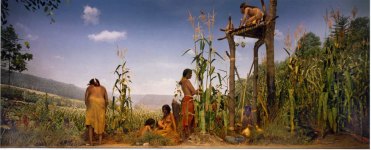A Guide to THE THREE SISTERS Diorama
AN IROQUOIS AGRICULTURAL FIELD at the NEW YORK STATE MUSEUM

Click on the image above for a closer look at the diorama - 74 KB
This diorama depicts the type of agriculture the Iroquois practiced when Europeans came to what is now Upstate New York, beginning about 1600. This exhibit strives to be authentic in all respects, from the major setting to the small details. The plants and animals displayed are accurate replications of those that inhabited the Iroquois world.
INTRODUCTION
Corn, beans and squash, The Three Sisters, were the principal crops of the Iroquois and other Native American groups in the northeastern United States, at the time Europeans arrived here about 1600. By this time, the Iroquois had been planting these three crops together for about 300 years. Corn and beans are not native to this area; they originated in tropical America where they were cultivated by early peoples, long before these crops were cultivated in the northeastern United States. Pumpkins and similar types of squash have a tropical origin, as well.
The earliest evidence of corn cultivation in New York is by 1200 years ago (A.D. 800) and beans, about 500 years later (A.D. 1300). The tropical varieties of squash did not enter the Northeast until about 1000 years ago (A.D. 1000). Some other types of squash originated in the eastern U.S.; they were cultivated in the Northeast by at least 2700 years ago (700 B.C.).
Cultivation of crops, gradually brought about a change in the Iroquois' way of life from hunting and gathering their sustenance in the woodlands, to cultivating crops in fields created by clearing patches of woodland. However, the Iroquois had cultivated plants native to the Northeast long before the 'Three Sisters' became the basis of their economy. Native plants were not only sources of food, but also provided medicines, beverages, dyes, etc. We know very little detail about these earlier agricultural practices.
Development of farming brought about the development of 'permanent' villages linked to the fields. Women, who did the farming, then lived year-round in the villages. This arrangement was established at least three hundred years before European arrival.
THE SCENE
The scene is in the Mohawk Valley about 30 miles west of the confluence of the Mohawk and Hudson rivers near Troy, N.Y. The view is to the southeast toward the Mohawk River where it flows through a narrows called the Noses, several miles west of Fonda, N.Y. The setting is a day in late August when the corn is beginning to mature. This is the time of the Green Corn Festival, one of the Iroquois' days of thanksgiving.